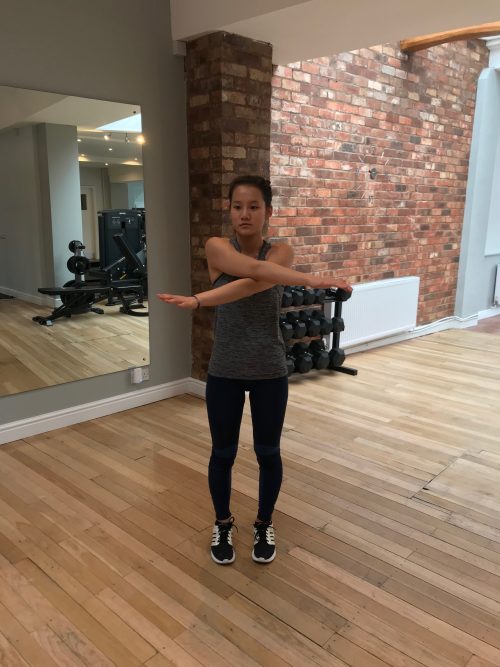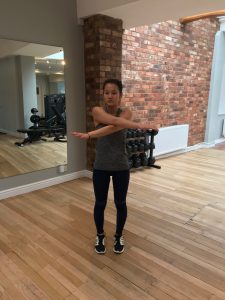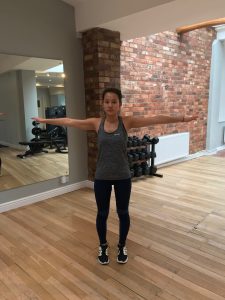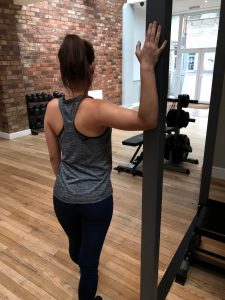Exercises for Improved Posture
30th October 2018

The common reality of modern life – sitting, hunched over. At a desk. In a meeting. At school. Watching the TV. Commuting. Staring at a phone. Repetitive behaviours lead to adaptations and changes to our body – commonly, hunched shoulders and back, chronic back pain and a weak core. Here we take a look at exercises for improved posture.
One way we can combat poor posture is by strengthening the muscles that are opposite to bending or curvature. The other means of combating a chronic issue such as hunched shoulders is to regularly stretch muscles that have tightened from extended periods of improper positioning being held.
Before we launch into discussing specific exercises that may be used to address hyperkyphosis (rounding forwards near the top of the spine) – here are three reasons why good posture should be valued:
- Pain reduction – when our bodies are compressed to a position that is not natural, it can lead to a chain of malfunction throughout different parts of the body. Often, chronic pain in areas such as the knees or lower back don’t originate with those locations – it’s other areas in the body. Hunched shoulders can be a real risk factor for back pain, as the misalignment at the top of the spine feeds into issues lower down.
- Reduced injury risk – With misalignment and improper positioning comes the risk that your body is moving in ways that could lead to more permanent damage. Although injuries cannot always be avoided, it’s a good idea to prevent them where we can by ensuring our body is in a place it can move at its strongest and most coordinated point.
- Confidence – people with good posture stand tall, produce and command the room. Clearly, this is beneficial in both a professional and personal sense.
With those three reasons behind you, we’ll now discuss some practical methods for addressing hyperkyphosis.
Regular stretching of the pectorals is incredibly important. The pectorals are our chest muscles, and they run essentially horizontally from each shoulder to the centre of the ribs (the sternum). When these are tight, they move and roll th shoulders inwards.
On the contrary, the rear deltoids (the shoulder muscles on your back that join the back of the shoulder to your shoulder blades and neck) are often weak, and undertrained even in people who are generally active. This means they remain stretched, allowing tight pectorals to pull the shoulders forward even more.
By strengthening the rear deltoids, they become more adept at pulling your shoulder blades back, bringing you to a more upright position. However, to exercise them properly, our chest must first be opened up and relaxed so that pulling and flying movements (such as rear delt raises, flyes and cable/resistance band pulls) can be executed with a good range of motion. Range of motion is important, as it enables us to perform exercises to our best capacity, eliciting a more potent training stimulus.
Before working out, perform dynamic stretches to warm up the muscles and to prevent any additional tightness (as outlined in one of our October blogs). Pectoral specific work includes dynamic stretches like arm swings. Start with your arms outstretched to the sides, like your torso and arms create the letter T. Swing your arms towards the midline of your body, arms still straight, hands pointing ahead of you. One arm will cross under the other as they go to meet, then you swing straight back out towards the T position. Repeat so that you alternate which hand goes above the other at the central position 10-15 times.


The above dynamic stretch is also good to do when you’re on a break after sitting at work, school or university for extended periods.
After a workout , you can stretch your pectorals by forming a right angle between your bicep and forearm, with your arm out to the side (similar to the T position but this time only one arm is used at a time and your arm is bent). Keeping that position, lean your forearm onto a pillar or wall, then twist your torso away from your arm so that you stretch your chest.
If you have just worked out your chest, it is likely to be especially tight – so hold for approximately 30 seconds on each side, deepening the stretch by leaning in further every ten seconds or so. If you are stretching at any other point, still hold the stretch for a similar length of time, but be wary of pushing the stretch too far if the muscles are cold.

As for rear deltoid strengthening, here are three exercises you may have programmed to do during FIT Friends workouts or 1:1 sessions with one of our PTs:
- Rear Delt Cable Flyes
Standing upright, you will hold on to cables at shoulder height in front of you, and then sweep them in an arc to slightly behind your torso, with your arms kept in a locked, mostly straight position. This helps to train the muscles that pull your shoulders back and away from the chest.
2. Bent Over Rear Delt Raises (dumbbells)
Leaning forward at the hips with a neutral spine either sitting down or standing up, dumbbells will be raised from the side of your body with your palms facing the side of your legs to around shoulder height. This also trains the musculature of the upper back, but from a slightly different angle.
3. Resistance Band Pulls (with hold)
Holding ourselves in an upright position for a set period of time needs to become a learned behaviour once more. Pulling against the resistance band incites the strength element to train the upper back, and holding that retracted position adds an extra stimulus of tension as you have to resist the urge to let the band come forwards once more. You’ll feel this one slightly differently to the others (it seems easy at first!) but is a great move for anybody of any ability level to include in their regime.
As a chronic issue, back rounding is not likely to be solved overnight. However, diligent stretching and specific exercise can make a marked difference to getting you walking around with your head held high once more.
